Identify a Parasite
Extermination Dynamique : Identify a Parasite in Greater Montreal
Recognize a Parasite
It is not always easy to identify an insect. To do this, you can bring a specimen to the exterminator or even send a photo by email. Our technicians at Extermination Dynamique can identify it and give you a free estimate.
Identify an Insect in Greater Montreal
Spider
 This arachnid weaves webs to capture its insect victims. Spiders have eight legs and multiple eyes. There are thousands of species of spiders, but in Quebec we have only around 700 species. The spider is responsible for a certain biological control because it consumes a large amount of insects.
This arachnid weaves webs to capture its insect victims. Spiders have eight legs and multiple eyes. There are thousands of species of spiders, but in Quebec we have only around 700 species. The spider is responsible for a certain biological control because it consumes a large amount of insects.
Cloporte
 Cet arthropode est en fait un crustacé terrestre nocturne. Ce dernier a 2 paires d’antennes, est de couleur terne et possède 7 paires de pattes. Le cloporte aime les endroits sombres et humides et se nourrit de matières végétales en décomposition.
Cet arthropode est en fait un crustacé terrestre nocturne. Ce dernier a 2 paires d’antennes, est de couleur terne et possède 7 paires de pattes. Le cloporte aime les endroits sombres et humides et se nourrit de matières végétales en décomposition.
Beetle
 Beetles are round in shape and are well known for their spots. If the specimen is yellow, orange or red, it will have black spots and if it is black, it will have yellow or orange spots. Beetles hibernate in winter, breed in spring and larvae develop in summer.
Beetles are round in shape and are well known for their spots. If the specimen is yellow, orange or red, it will have black spots and if it is black, it will have yellow or orange spots. Beetles hibernate in winter, breed in spring and larvae develop in summer.
Cockroach
 Cockroaches are brown or black and have a flattened body. This insect has two long antennae and two pairs of wings. A cockroach that lives inside can lay eggs all year. The cockroach is a fairly large insect and can become invasive since it eats food in kitchens and carries bacteria, fungi and parasites to other areas of the house. Cockroaches adapt quickly to change and to poisons.
Cockroaches are brown or black and have a flattened body. This insect has two long antennae and two pairs of wings. A cockroach that lives inside can lay eggs all year. The cockroach is a fairly large insect and can become invasive since it eats food in kitchens and carries bacteria, fungi and parasites to other areas of the house. Cockroaches adapt quickly to change and to poisons.
Carpenter Ant
 Carpenter ants are black with shades of red or brown, depending on the species. The nest is usually built in a tree trunk or stump. After 3-6 years, a colony has more than 2,000 occupants. Carpenter ants like to live in moist wood. They tunnel into rotten wood. However, their presence should not be tolerated in a house since they could cause serious damage to the structure.
Carpenter ants are black with shades of red or brown, depending on the species. The nest is usually built in a tree trunk or stump. After 3-6 years, a colony has more than 2,000 occupants. Carpenter ants like to live in moist wood. They tunnel into rotten wood. However, their presence should not be tolerated in a house since they could cause serious damage to the structure.
Wasp
 A social insect, the wasp is black with yellow stripes on the thorax and head. The queen establishes the colony in a nest of paper or underground. This insect can be aggressive and does not hesitate to sting. The wasp injects venom with its stinger to paralyze its prey. If a human is stung by a wasp, the victim will feel a sharp pain (it is very important to remove the stinger if it is in your skin), but the bite is usually harmless. However, if you are allergic or if you get stung repeatedly, you will need to go to the hospital as soon as possible.
A social insect, the wasp is black with yellow stripes on the thorax and head. The queen establishes the colony in a nest of paper or underground. This insect can be aggressive and does not hesitate to sting. The wasp injects venom with its stinger to paralyze its prey. If a human is stung by a wasp, the victim will feel a sharp pain (it is very important to remove the stinger if it is in your skin), but the bite is usually harmless. However, if you are allergic or if you get stung repeatedly, you will need to go to the hospital as soon as possible.
Fly
 This winged insect has six legs and its coloring varies depending on the species. Usually, flies need water to grow; the egg, larva and pupa develop in water until they reach maturity and fly away. The presence of flies can become rather annoying. Indeed, their constant buzzing and stubborn tendency to alight on people contribute to this feeling.
This winged insect has six legs and its coloring varies depending on the species. Usually, flies need water to grow; the egg, larva and pupa develop in water until they reach maturity and fly away. The presence of flies can become rather annoying. Indeed, their constant buzzing and stubborn tendency to alight on people contribute to this feeling.
Earwig
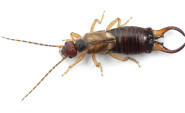 This nocturnal insect is recognizable by the tails located at the end of its abdomen. It is herbivorous, scavenger or omnivorous, depending on the species. Earwigs often feed in gardens, but as their presence is useful (they eat harmful insects or very old plants), you might want to reduce their population rather than exterminate them.
This nocturnal insect is recognizable by the tails located at the end of its abdomen. It is herbivorous, scavenger or omnivorous, depending on the species. Earwigs often feed in gardens, but as their presence is useful (they eat harmful insects or very old plants), you might want to reduce their population rather than exterminate them.
Silverfish
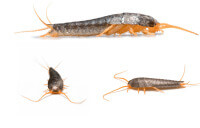 The silverfish and firebrat live outside in warm climates, but in Canada they live inside to get away from the cold. Both have long bodies with antennae and are covered with scales. Silverfish are covered with silvery scales and firebrats are beige. They both love damp areas such as basements, bathrooms and buildings where there is water leakage. Silverfish will be found in cooler locations and firebrats in warmer areas.
The silverfish and firebrat live outside in warm climates, but in Canada they live inside to get away from the cold. Both have long bodies with antennae and are covered with scales. Silverfish are covered with silvery scales and firebrats are beige. They both love damp areas such as basements, bathrooms and buildings where there is water leakage. Silverfish will be found in cooler locations and firebrats in warmer areas.
Bedbug
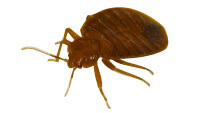 The bedbug feeds on the blood of sleeping people and animals. Two species feed exclusively on human blood while others also consume the blood of birds and mammals. The bedbug moves at night and bites its host when sleeping. Upon waking, the victim notices small red bites that are often in a line or in a group. The bites are usually harmless but can cause itching or redness. Also, some people may be allergic. It is best to eliminate an invasion of bedbugs as quickly as possible before they reproduce and spread throughout your home.
The bedbug feeds on the blood of sleeping people and animals. Two species feed exclusively on human blood while others also consume the blood of birds and mammals. The bedbug moves at night and bites its host when sleeping. Upon waking, the victim notices small red bites that are often in a line or in a group. The bites are usually harmless but can cause itching or redness. Also, some people may be allergic. It is best to eliminate an invasion of bedbugs as quickly as possible before they reproduce and spread throughout your home.
Identify a Rodent in the Greater Montreal
Bat
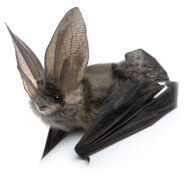 This nocturnal flying mammal is distinguished by a membrane linked to its forelimbs that acts like a wing. It orients itself using sound waves created by the cries it emits. Since bats eat insects, they sometimes move into attics. You must therefore make your attic inaccessible.
This nocturnal flying mammal is distinguished by a membrane linked to its forelimbs that acts like a wing. It orients itself using sound waves created by the cries it emits. Since bats eat insects, they sometimes move into attics. You must therefore make your attic inaccessible.
Squirrel
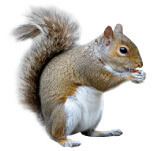 This small bushy tailed rodent is very skilled in the trees and is capable of jumping large distances. It has a habit of storing provisions for the winter. Squirrels can be harmful to humans because they sometimes take up residence in homes and gnaw on wires or equipment.
This small bushy tailed rodent is very skilled in the trees and is capable of jumping large distances. It has a habit of storing provisions for the winter. Squirrels can be harmful to humans because they sometimes take up residence in homes and gnaw on wires or equipment.
Rat
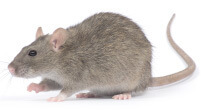 This rodent has a long scaly tail, a pointed snout and a gray coat. It lives in the countryside as well as the city. If rats find their way into a building, they must be removed quickly, because they carry diseases and reproduce very quickly.
This rodent has a long scaly tail, a pointed snout and a gray coat. It lives in the countryside as well as the city. If rats find their way into a building, they must be removed quickly, because they carry diseases and reproduce very quickly.
Raccoon
 The fur of this mammal is gray and brown, its tail is striped and it has a black mask. Of a curious and intelligent nature, it is always in search of food and will try to get it by any means. The presence of a raccoon is inconvenient since it can take up residence in your attic, rummage through your trash or make a nest under your porch.
The fur of this mammal is gray and brown, its tail is striped and it has a black mask. Of a curious and intelligent nature, it is always in search of food and will try to get it by any means. The presence of a raccoon is inconvenient since it can take up residence in your attic, rummage through your trash or make a nest under your porch.
Mouse
 This small, omnivorous rodent with a whitish or gray coat is characterized by a long snout and a long thin tail. Females can have several litters per year; they reproduce very quickly. Mostly nocturnal, mice live in burrows outside but also inside when they successfully break into houses, barns or other buildings.
This small, omnivorous rodent with a whitish or gray coat is characterized by a long snout and a long thin tail. Females can have several litters per year; they reproduce very quickly. Mostly nocturnal, mice live in burrows outside but also inside when they successfully break into houses, barns or other buildings.
